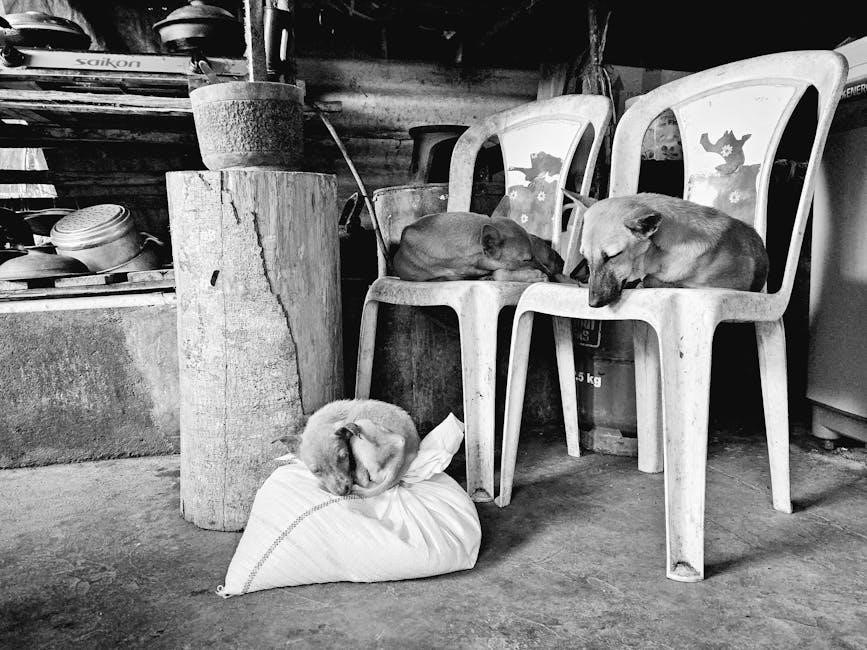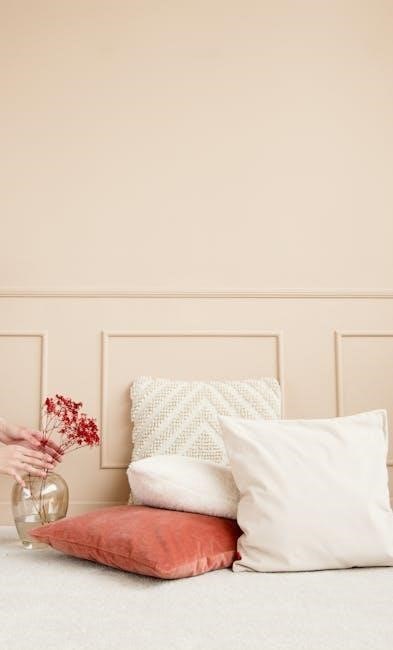Welcome to our comprehensive guide on sleep sacks! If you’re new to the world of baby sleep solutions‚ you’ve likely wondered: Are sleep sacks necessary? This section introduces you to the essentials of sleep sacks‚ their purpose‚ and how they promote safe‚ comfortable sleep for your baby. Discover how this simple solution can transform your little one’s sleep routine and your peace of mind.
What is a Sleep Sack?
A sleep sack is a wearable blanket designed for infants and toddlers‚ promoting safe sleep by replacing loose bedding. It ensures comfort and security while maintaining a safe sleep environment.
2.1 Definition and Purpose
A sleep sack is a wearable blanket designed for infants and toddlers‚ serving as a safe and cozy alternative to traditional bedding. It is typically made of soft‚ breathable fabric and zippers or snaps for easy dressing. The primary purpose of a sleep sack is to provide a secure and comfortable environment for your baby to sleep in‚ ensuring they stay warm without the risks associated with loose blankets. It is especially useful for preventing accidental suffocation and overheating‚ which are key safety concerns for newborns and young children. Sleep sacks also help maintain a consistent body temperature‚ promoting better sleep quality. Additionally‚ they offer a sense of security and comfort‚ similar to swaddling‚ while allowing for more freedom of movement. This makes them an essential item for many parents looking to create a safe and restful sleep routine for their little ones.
2.2 How It Differs from Swaddling
Sleep sacks differ significantly from swaddling‚ as they offer a safer and more practical alternative. Swaddling involves tightly wrapping a baby in a blanket‚ which can restrict movement and pose safety risks if not done correctly. In contrast‚ sleep sacks are designed to allow for natural leg and hip movement‚ promoting healthy development while keeping the baby warm and secure. Unlike swaddling‚ sleep sacks do not require precise wrapping techniques‚ reducing the risk of overheating or SIDS. They also provide ease of use‚ with zippers or snaps for quick changes‚ whereas swaddling can be time-consuming and may disrupt the baby’s sleep when adjusting. Sleep sacks are generally recommended for older infants who have outgrown swaddling‚ offering a transition to more independent movement while maintaining a cozy environment. This makes sleep sacks a safer‚ more versatile‚ and long-term solution for baby sleep needs.

Benefits of Using a Sleep Sack
Sleep sacks enhance safety‚ comfort‚ and sleep quality for babies while offering convenience for parents. They promote better sleep patterns‚ reduce the risk of SIDS‚ and provide a cozy‚ secure environment.
3.1 Enhanced Safety
Sleep sacks significantly enhance baby safety by reducing the risk of SIDS and ensuring a secure sleep environment. They prevent overheating and keep babies on their backs‚ promoting safe sleep practices. Unlike loose bedding‚ sleep sacks stay in place‚ minimizing the risk of fabric covering the face. Designed with breathable materials‚ they maintain a safe body temperature. The snug fit ensures babies cannot roll onto their stomachs or get tangled‚ reducing accidental suffocation risks. Sleep sacks also eliminate the need for blankets‚ which can be a choking hazard. By providing a controlled environment‚ they align with pediatric recommendations for safe sleep‚ giving parents peace of mind while their baby sleeps soundly.

3.2 Improved Comfort for Babies
Sleep sacks are designed to enhance a baby’s comfort‚ ensuring they feel secure and cozy throughout the night. The snug‚ wraparound design mimics the womb‚ providing a sense of familiarity and reassurance. Unlike traditional bedding‚ sleep sacks allow for natural movement‚ letting babies stretch their legs and arms freely while preventing them from feeling restricted. The soft‚ breathable materials used in sleep sacks are gentle on sensitive skin‚ reducing the risk of irritation. Additionally‚ sleep sacks help regulate body temperature‚ keeping babies warm without overheating‚ which is a common concern for parents. This balanced comfort promotes better sleep quality and helps babies feel calm and relaxed. By addressing both physical and emotional comfort needs‚ sleep sacks create a nurturing environment that supports healthy development and restful sleep.
3.3 Promotion of Better Sleep
Sleep sacks are a valuable tool for promoting better sleep for babies. By providing a consistent and familiar sleeping environment‚ they help babies establish a healthy sleep routine. The snug fit of a sleep sack ensures that your baby feels secure‚ reducing the likelihood of restlessness and nighttime wakings. Additionally‚ the design allows for natural movement‚ which can help your baby self-soothe and fall asleep more easily. Many parents report that their babies sleep longer and more soundly when using a sleep sack‚ as it helps regulate their body temperature and prevents overheating. This consistent comfort fosters a deeper sleep cycle‚ making it easier for babies to stay asleep throughout the night. By addressing these key factors‚ sleep sacks play a significant role in improving the quality and duration of your baby’s sleep‚ ensuring they—and you—get the rest needed for healthy development.
3.4 Ease of Use for Parents
Sleep sacks are designed with parents’ convenience in mind‚ offering a practical solution for bedtime routines. Their simple‚ zipper-free or easy-closure designs make it quick to dress and undress your baby‚ while the lightweight material ensures ease of use. Many sleep sacks feature two-way zippers‚ allowing for effortless diaper changes without fully removing the sack. This design minimizes disruptions‚ helping your baby stay calm and asleep. Additionally‚ sleep sacks are easy to care for‚ as they are machine washable and dry quickly. The straightforward nature of sleep sacks makes them a stress-free option for parents‚ saving time and energy during late-night routines. Their user-friendly design ensures that parents can focus on their baby’s comfort and sleep without hassle. This ease of use makes sleep sacks a popular choice for busy families seeking a reliable sleep solution.

How to Choose the Right Sleep Sack
Choosing the right sleep sack involves considering size‚ material‚ and features to ensure safety and comfort. Look for breathable fabrics‚ proper fit‚ and functional designs to meet your baby’s needs.
4.1 Considering the Right Size
Choosing the right size for a sleep sack is crucial for your baby’s safety and comfort. A sleep sack that is too tight can restrict movement‚ while one that is too loose may pose a safety risk. Always refer to the manufacturer’s sizing chart‚ which typically bases measurements on your baby’s weight and length. Ensure the sack allows for a snug fit around the chest but doesn’t impede arm movement. Some sleep sacks also offer adjustable features‚ such as zippers or snaps‚ to customize the fit as your baby grows. Proper sizing ensures the sleep sack stays in place and promotes safe sleep practices. Additionally‚ consider your baby’s activity level and mobility when selecting a size. Regularly check the fit as your baby grows to ensure ongoing comfort and safety. A well-fitted sleep sack can significantly enhance your baby’s sleep quality and your peace of mind.
4.2 Selecting the Appropriate Material
Selecting the right material for a sleep sack is essential for ensuring your baby’s safety‚ comfort‚ and sleep quality. Opt for breathable‚ natural fabrics like cotton‚ bamboo‚ or muslin‚ which allow for proper airflow and help regulate your baby’s body temperature. These materials are gentle on sensitive skin and reduce the risk of overheating‚ a key factor in safe sleep practices. Avoid synthetic fabrics that can trap heat and cause discomfort. Additionally‚ consider seasonal variations—lightweight materials for summer and slightly heavier‚ insulating fabrics for colder months. Some sleep sacks also feature moisture-wicking properties‚ ideal for babies who tend to sweat. Look for materials with certifications like OEKO-TEX‚ ensuring they are free from harmful chemicals. Ultimately‚ the right fabric will balance safety‚ comfort‚ and practicality‚ providing your baby with a restful sleep environment. Always prioritize materials that align with your baby’s specific needs and climate conditions.
4.3 Design and Features to Look For
When selecting a sleep sack‚ pay attention to thoughtful design elements that enhance safety‚ comfort‚ and practicality. Look for sleep sacks with a roomy‚ hip-friendly design to accommodate natural leg movement‚ promoting healthy hip development. Opt for sacks with a two-way zipper or easy-open snaps at the bottom for convenient diaper changes without disturbing your baby. Adjustable shoulder straps ensure a secure fit as your baby grows. Some sleep sacks feature detachable sleeves or convertible arm openings‚ offering versatility for different seasons and preferences. Ensure the design is free from loose threads‚ buttons‚ or small parts that could pose a choking hazard. Additionally‚ consider sleep sacks with breathable mesh panels for temperature regulation or built-in mittens to prevent scratching. A well-designed sleep sack should balance simplicity with functionality‚ making it easy to use while prioritizing your baby’s comfort and safety.
4.4 Additional Features and Accessories
Additional features and accessories can enhance the functionality and convenience of a sleep sack. Some sleep sacks come with detachable sleeves‚ allowing for versatility in different climates or preferences. Others may include built-in mittens to prevent babies from scratching their faces. Look for sleep sacks with adjustable straps or extenders to accommodate growth. Some designs feature a sleep sack extender‚ which allows for longer use as your baby grows. Accessories like matching sleep masks or travel bags can also be useful for overnight trips. Certain sleep sacks include a pacifier pocket for easy access or a sleep tracker to monitor your baby’s sleep patterns. Additionally‚ some brands offer seasonal options‚ such as lightweight summer sacks or winter sacks with extra layers. These extra features can make a sleep sack more practical and adaptable to your baby’s needs‚ ensuring comfort and convenience for both baby and parent.

How to Use a Sleep Sack Effectively
Using a sleep sack effectively involves a few simple steps to ensure your baby’s safety and comfort. Start by choosing the right size and material for the season. Place your baby in the sleep sack with their arms either in or out‚ depending on their preference and mobility needs. Always position your baby on their back to promote safe sleep practices. Avoid overheating by dressing your baby in lightweight clothing underneath. For easier diaper changes‚ opt for a sleep sack with a zippered bottom or side opening. Use the sleep sack consistently to help your baby develop a predictable sleep routine. Regularly check for proper fit to ensure the sack isn’t too tight or restrictive. By following these guidelines‚ you can help your baby sleep soundly while maintaining comfort and safety throughout the night.

Transitioning from Swaddling to a Sleep Sack
Transitioning your baby from swaddling to a sleep sack can be a smooth process with careful planning. Start by introducing the sleep sack while still swaddling to help your baby adjust to the new texture and feel. Gradually reduce the tightness of the swaddle over a few nights‚ allowing your baby to get used to the freedom of movement the sleep sack provides. Monitor your baby’s comfort and sleep quality during this transition. If your baby seems resistant‚ try using a sleep sack with a snug fit to mimic the swaddling sensation. Ensure the sleep sack is the right size and material for your baby’s comfort. Consistency is key‚ so maintain a regular bedtime routine to help your baby adapt. This transition not only promotes safer sleep but also gives your baby the freedom to move naturally‚ supporting their developmental needs.

Safety Tips for Using a Sleep Sack
Using a sleep sack safely is essential to ensure your baby’s well-being. Always choose a sleep sack made from breathable‚ natural materials to prevent overheating. Ensure the sack fits properly—neither too tight nor too loose—to avoid restricting movement or posing a tripping hazard. Avoid using loose bedding or blankets‚ as the sleep sack is designed to replace them. Keep the room at a comfortable temperature to prevent overheating‚ and never leave the sleep sack unzipped or partially closed. Avoid adding extra padding or toys inside the sack‚ as this can create a suffocation risk. Regularly inspect the sleep sack for tears or loose threads and wash it according to the manufacturer’s instructions. By following these guidelines‚ you can help create a safe and cozy sleep environment for your baby.

Frequently Asked Questions
- Is a sleep sack necessary? It enhances safety and comfort‚ promoting better sleep for babies.
- Can babies move freely in a sleep sack? Yes‚ it allows natural movement while keeping them cozy.
- How to clean and maintain a sleep sack? Wash it regularly with mild detergent and follow care instructions.
8.1 Is a Sleep Sack Necessary?
While a sleep sack isn’t mandatory‚ it offers significant benefits for baby sleep safety and comfort; It reduces the risk of SIDS by preventing overheating and keeping the face uncovered. Many parents find it essential for promoting consistent sleep patterns and easing the transition from swaddling. However‚ whether to use one depends on your baby’s needs and preferences. If your baby sleeps well without it‚ it’s not required‚ but its advantages make it a worthwhile investment for most families.
8.2 Can Babies Move Freely in a Sleep Sack?
Sleep sacks are designed to allow babies to move their arms freely while keeping their legs slightly restricted‚ mimicking the womb environment. This design prevents tangling and rolling over‚ enhancing safety. Babies can still kick their legs and move comfortably‚ promoting healthy hip development. The sack’s material is lightweight and breathable‚ ensuring your baby stays comfortable. While it doesn’t restrict natural movement‚ it does limit excessive wiggling that could disrupt sleep. This balance of freedom and security helps babies sleep soundly without compromising their ability to move. Parents often find it ideal for active babies who need a sense of freedom but still benefit from the structure a sleep sack provides.
8.3 How to Clean and Maintain a Sleep Sack
Proper cleaning and maintenance of a sleep sack are essential to ensure its longevity and safety for your baby. Always check the care label for specific instructions‚ as materials may vary. Most sleep sacks are machine washable and can be tumble dried on a low setting. Use a gentle detergent to avoid irritating your baby’s sensitive skin. For tougher stains‚ spot clean with a soft cloth before washing. Avoid using bleach or harsh chemicals‚ as they can damage the fabric. Reshape the sleep sack while it’s damp to maintain its original form. Store it in a cool‚ dry place when not in use. Regular washing and proper drying will keep the sleep sack fresh and hygienic. For organic or bamboo materials‚ consider air-drying to preserve their natural properties. Proper care ensures your sleep sack remains a safe and comfortable choice for your baby.

Addressing Common Concerns
Many parents have questions about sleep sacks‚ such as whether they restrict movement‚ suit all seasons‚ or are suitable for every baby. This section tackles these concerns head-on‚ offering reassurance and practical advice to help you make informed decisions for your child’s comfort and safety.
9.1 Do Sleep Sacks Interfere with Movement?
One of the most common concerns about sleep sacks is whether they restrict a baby’s movement. However‚ most sleep sacks are designed to allow for natural arm and leg movement‚ ensuring your baby can stretch and move comfortably. The loose fit around the legs and armholes typically prevent any feeling of confinement. In fact‚ many parents find that sleep sacks help their babies sleep more soundly by preventing the startle reflex‚ which can wake them up unnecessarily. As long as the sleep sack is the right size and not too tight‚ it should not interfere with your baby’s ability to move freely. This balance of freedom and comfort makes sleep sacks a practical choice for promoting safe and restful sleep.
9.2 Can Sleep Sacks Be Used in Different Seasons?
Sleep sacks are versatile and can be used in different seasons by choosing the right material and thickness. For warmer months‚ lightweight‚ breathable fabrics like cotton or bamboo are ideal‚ allowing airflow and preventing overheating. In cooler weather‚ sleep sacks made from thicker‚ insulating materials such as fleece or wool keep your baby cozy without the need for heavy blankets. Many sleep sacks also feature adjustable designs‚ enabling parents to layer clothing underneath for added warmth. Additionally‚ some models come with detachable sleeves or zippered openings for temperature regulation. This adaptability ensures that sleep sacks remain a practical and safe sleep solution year-round‚ regardless of the season. By selecting the appropriate fabric and design‚ parents can maintain their baby’s comfort and safety in any climate.
9.3 Are Sleep Sacks Suitable for All Babies?
Sleep sacks are generally suitable for most babies‚ but there are exceptions to consider. Premature infants or those with specific medical conditions may require specialized sleep solutions‚ so consulting a pediatrician is essential in such cases. For babies with special needs or reflux‚ sleep sacks can still be used‚ but parents should ensure they allow for proper positioning and comfort. Active or restless babies may benefit from sleep sacks with built-in arm holes for freedom of movement. Additionally‚ babies with eczema or sensitive skin should use sleep sacks made from hypoallergenic‚ organic materials to avoid irritation. Ultimately‚ while sleep sacks are a safe and practical choice for many‚ it’s important to tailor the selection to your baby’s unique needs and health requirements. Always prioritize your baby’s comfort and safety‚ and consult a healthcare provider if unsure.
